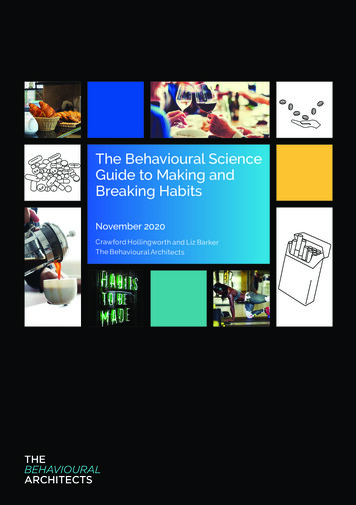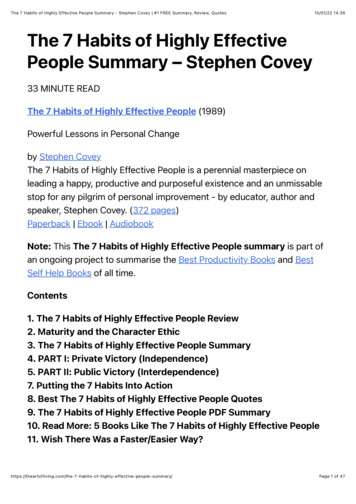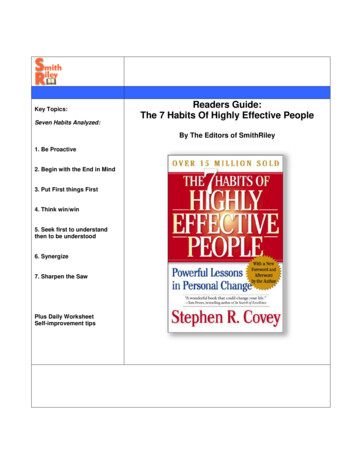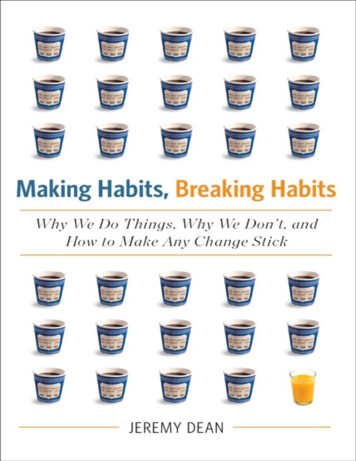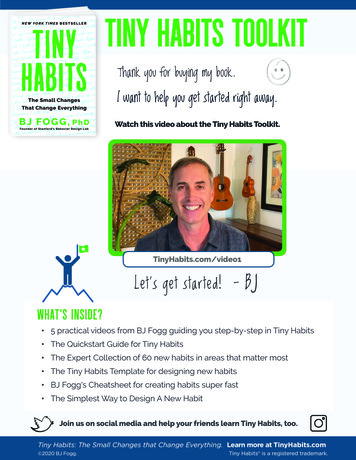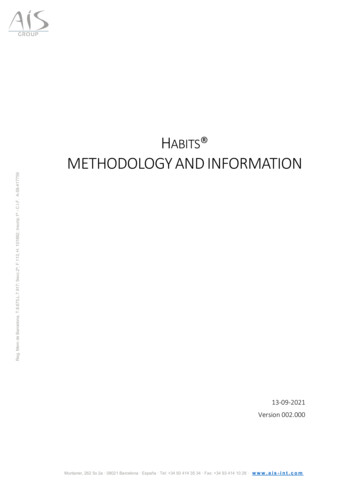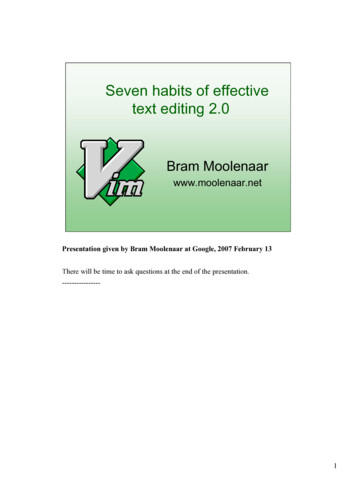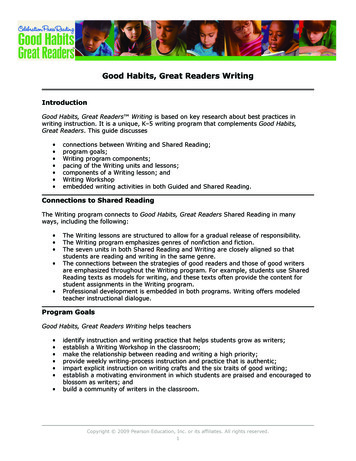
Transcription
Good Habits, Great Readers WritingIntroductionGood Habits, Great Readers Writing is based on key research about best practices inwriting instruction. It is a unique, K–5 writing program that complements Good Habits,Great Readers. This guide discusses connections between Writing and Shared Reading;program goals;Writing program components;pacing of the Writing units and lessons;components of a Writing lesson; andWriting Workshopembedded writing activities in both Guided and Shared Reading.Connections to Shared ReadingThe Writing program connects to Good Habits, Great Readers Shared Reading in manyways, including the following: The Writing lessons are structured to allow for a gradual release of responsibility.The Writing program emphasizes genres of nonfiction and fiction.The seven units in both Shared Reading and Writing are closely aligned so thatstudents are reading and writing in the same genre.The connections between the strategies of good readers and those of good writersare emphasized throughout the Writing program. For example, students use SharedReading texts as models for writing, and these texts often provide the content forstudent assignments in the Writing program.Professional development is embedded in both programs. Writing offers modeledteacher instructional dialogue.Program GoalsGood Habits, Great Readers Writing helps teachers identify instruction and writing practice that helps students grow as writers;establish a Writing Workshop in the classroom;make the relationship between reading and writing a high priority;provide weekly writing-process instruction and practice that is authentic;impart explicit instruction on writing crafts and the six traits of good writing;establish a motivating environment in which students are praised and encouraged toblossom as writers; andbuild a community of writers in the classroom.Copyright 2009 Pearson Education, Inc. or its affiliates. All rights reserved.1
Program ComponentsGood Habits, Great Readers Writing has resources that help provide focused writinginstruction. The program relies on real literature to model writing and highlight techniquesused by published authors.Teacher’s GuideThe Teacher’s Guide serves as the Writingprogram’s primary resource. It is organizedaround genres and modes or forms ofwriting. In the seven units in the Teacher’sGuide, lessons are laid out so teachers canlead students through fiction and nonfictiongenres, work in varied writing modes, andemphasize the six traits of writing.Conference CardThis laminated card is a helpful resourcewhen conferencing with students about theirwriting. It serves as the backbone for theone-on-one meetings with students. Thiscard contains prompts, reflection questions,and a guide to advising students based ontheir responses.Teacher Resource CDThis CD contains resources that supportinstruction across the grades. These availableresources include a chart on the steps of the writingprocess;a list of the six traits of writing;an editing checklist;student rubrics for each of the six traitsof writing;benchmark papers that help studentsbecome familiar with the six traits;model texts and graphic organizers formany modes of writing;valuable assessment resources, suchas a Conferencing Record, for students;andscored anchor papers that providesamples of student writing.Copyright 2009 Pearson Education, Inc. or its affiliates. All rights reserved.2
Skills for Super Writers: Student andTeacher’s EditionsThis workbook and companion Teacher’sGuide can strengthen students’ grammar,usage, and mechanics skills. The StudentWorkbook provides additional practice to helpstudents develop revising and editing skills.Pacing of the Writing Units and LessonsGood Habits, Great Readers Writing is organized into seven units per grade. The programhas been planned to give teachers flexibility in weekly and monthly lesson plans. In GradesK–1, there are twenty-four weeks of writing instruction. During each week, there are threedays of instruction. The goal of the Writing program in the early grades is to get studentsto start to write and to think of themselves as writers by communicating their thoughts inpictures or words. Students start writing right from the beginning of each grade, and theycontinue to write throughout the year.In Grades 2–5, there are twenty-six weeks of instruction. For these grades, there are threeto four lessons per week. From the start, students are introduced to the writing process.They generate ideas or topics to write about, plan their writing, make drafts, edit andrevise, and publish their work.Copyright 2009 Pearson Education, Inc. or its affiliates. All rights reserved.3
The Pacing Chart shown here gives an overview of what teachers do with their class in eachunit of Writing for Grade 4. The following are some of the features of the Writing programreflected in this Pacing Chart: Genre: The program is organized by the most relevant fiction and nonfiction genresstudents need to learn as both readers and writers.Mode: Student will practice different modes or forms of writing, including descriptive,narrative, response to reading, creative, information, writing to explain and learn, andpersuasive.Trait Time: These lessons teach the six traits of writing.Note: Trait Time is introduced in second grade. The other features are addressed inthe program when developmentally appropriate.Craft: The chart can also be used to determine which lessons provide an opportunity todraw out specific aspects of polished writing, such as using dialogues, varying sentencestructure, and adding details.Copyright 2009 Pearson Education, Inc. or its affiliates. All rights reserved.4
Components of the Writing LessonAll lessons in Good Habits, Great Readers Writing follow the same structure. Thirty-five tofifty minutes a day is allotted for daily writing instruction in the classroom. Each lesson inthe Teacher’s Guide provides ten to fifteen minutes of direct instruction. The rest of the timeis spent having students write, conference with their teacher, or publish their writing. Thefollowing features are found in the Good Habits, Great Readings Writing lessons:MaterialsEach lesson has two lists of materials thathelp teachers and students collect the itemsthey need for a lesson.ObjectiveThe simply stated objective aligns with manystate standards and follows the scope andsequence for the program.IntroduceThe Introduce section provides context forthe lesson, connecting the lesson to previousinstruction and naming the main teachingpoint of the day.TeachThe Teach section gives the teacher theopportunity to demonstrate a writingprocess, skill, or strategy and then have theclass practice it.Copyright 2009 Pearson Education, Inc. or its affiliates. All rights reserved.5
ApplyThis portion of the writing lesson providesclosure to the lesson by having studentswork independently. On the first day of anew mode of writing, independent writing isoptional. On all other days, students write ontheir own.Conferencing PromptsIn one or two lessons per week, ConferencePrompts offer tips for conferencing withstudents on their independent work. Thesetips are prompts for praising students ontheir work and provide thoughtful questionsthat encourage students to reflect on theirwriting.ShareThe Share section is the teacher-directed orstudent-directed lesson wrap-up.ELL TipThe ELL Tip section provides two tips thatoffer scaffolding for the week’s lessons forEnglish language learners. The tips also suggest support for important content, concepts,and vocabulary.Grammar/Usage/MechanicsThis lesson feature provides a Grammar/Usage/Mechanics Mini-lesson at the back ofthe Teacher’s Guide. There is also a follow-upactivity that appears at the end of each unit.Teacher TipTeacher Tips are useful suggestions, providedby experienced teachers, for contentinstruction and classroom managementduring the Writing Workshop.Wrap UpWrap Up includes two sections: thePublishing portion and the InformalAssessment section. The Publishing portionsuggests an authentic opportunity forstudents to publish or share their work, andthe Informal Assessment provides ReflectiveWriting questions or prompts for students.Unit PlannerThe Unit Planner shows how the Writinglessons are organized and connected to oneanother, as well as how they relate to SharedReading lessons.Copyright 2009 Pearson Education, Inc. or its affiliates. All rights reserved.6
The Writing WorkshopThe goal of the Writing Workshop is to build a community of writers in which risk-taking isencouraged and students help each other grow. The units are presented in four steps:Step 1: Introduce concepts and skillsStep 2: Teach (including teacher modeling)For the first five to fifteen minutes, theclass meets as a group. During this time,the teacher gives a Mini-lesson on a writingconcept or craft. This time frame includesboth the Introduce and Teach segments of alesson in the Teacher’s Guide. This segmentoften involves sharing a writing modelfrom the Teacher Resource CD or using theteacher’s writing as a model for the class.Step 3: Apply (independent writing)In the Apply portion of the workshop,students work independently on their writing.This segment should last twenty-five tothirty minutes. During this time, teacherstalk with individual students in brief writingconferences.Step 4: ShareThe last five to ten minutes of every WritingWorkshop should be reserved for sharing.During this segment, students share ashort portion of their writing. The Teacher’sGuide provides details for several sharingtechniques for the Writing lessons, including teacher-directed and modeled sharing;student partner sharing;small-group sharing; andwhole-class sharing.Copyright 2009 Pearson Education, Inc. or its affiliates. All rights reserved.7
Embedded Writing ActivitiesGood Habits, Great Readers Shared andGuided Reading also provide opportunitiesfor students to practice writing in responseto reading directly in the program.Each Guided Reading lesson plan in GradesK–5 includes writing activities that are tiedto each leveled reader.In Shared Reading for Grades K–3, CenterActivities include writing practice. In Grades4–5, the Shared Reading Mini-lessons focuson a writer’s craft. The weekly Wrap Upfeature Write About It also enables studentsto practice Extended Response Writing.ReviewThis guide explained the connections between Writing and Shared Reading in Good Habits,Great Readers. It explained the Writing program goals and components, discussed thepacing of the Writing units and lessons, and explored the components of a Writing lesson.Next, it detailed the goal and steps in a Writing Workshop. Finally, it reviewed the embeddedwriting activities found in both Guided and Shared Reading.For more information, please look for the other tutorials on Good Habits, Great Readers onmyPearsonTraining.com.Copyright 2009 Pearson Education, Inc. or its affiliates. All rights reserved.8
Good Habits, Great Readers Writing Introduction Good Habits, Great Readers Writing is based on key research about best practices in writing instruction. It is a unique, K-5 writing program that complements Good Habits, Great Readers. This guide discusses connections between Writing and Shared Reading; program goals;
